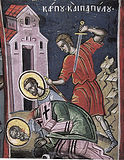

| Previous day | Next day |
| Old Style
October 13
|
Saturday |
New Style
October 26
|
| 18th Week after Pentecost. Tone 8. | No fast.
|
![]() Translation to Moscow of the Iveron Icon of the Most Holy Theotokos.
Translation to Moscow of the Iveron Icon of the Most Holy Theotokos. ![]() Hieromartyrs Carpus, bishop of Thyateira, and Papylus, deacon, and Martyrs Agathadorus and Agathonica, at Pergamus (251).
Hieromartyrs Carpus, bishop of Thyateira, and Papylus, deacon, and Martyrs Agathadorus and Agathonica, at Pergamus (251).
Martyr Florentius of Thessalonica (1st c.-2nd c.). Hieromartyr Benjamin, deacon, of Persia (421-424). St. Nicetas the Confessor, of Paphlagonia (ca. 838). St. Benjamin of the Kiev Caves (14th c.). New Martyr Zlata (Chryse) of Meglin, Bulgaria (1795). St. Anthony, metropolitan of Chkondidi, Georgia (1815), and his disciple James the Elder, hieromonk.
New Hieromartyr Nicholas Yermolov, archpriest, of Ordynskoye (Novosibirsk) (1937). Uncovering of the relics of New Hieromartyr Thaddeus (Uspensky), archbishop of Tver (1993).
Kazan Icon of the Most Holy Theotokos “Of the Seven Lakes” (17th c.).
St. Venantius, abbot, of the monastery of St. Martin in Tours (Gaul) (400). St. Luke of Demena, Sicily (984). Monk-martyr Jacob of Hamatoura Monastery (Lebanon) (late 13th. c.). New Martyr Bosiljka Rajicic of Kosovo (18th c).
Repose of Monk Athanasius of Valaam (1852).
Thoughts for Each Day of the Year
According to the Daily Church Readings from the Word of God
By St. Theophan the Recluse

Saturday. [II Cor. 3:12-18; Luke 6:1-10]
The Lord’s disciples pluck the ears of grain, rub them in their hands and eat them on the Sabbath—a deed very unimportant both in appearance and in essence; meanwhile the Pharisees could not restrain themselves and rebuked them. What made them raise this issue? In appearance—unreasoning zeal, but in essence—the spirit of judgmentalness. This sticks to everything and presents all in a sombre form of unlawfulness and destructiveness. This infirmity, to a greater or lesser degree, is common to almost all people who do not watch themselves. Not everyone will express judgmental thoughts in word, but it is rare for a person to refrain from them. Someone sits beside the heart and stirs up judgmentalness—it pours forth. But at the same time the judge himself is prepared to do deeds which are not good, as long as nobody sees, and he is unfailingly in a state that is not so good in some way. It is as though he judges and condemns for that very reason—in order to satisfy his inwardly insulted and suppressed feeling of righteousness with attacks on others, groundless as they may be. He who loves righteousness and stands in it, knowing how difficult it is to attain correctness in deeds and even more so in feelings, will never judge; he is ready sooner to cover with leniency not only small, but also great transgressions of others. The Lord does not judge the judging Pharisees, but indulgently explains to them that the disciples did something that anyone would excuse if they thought about it rightly. And it almost always is this way: think reasonably about your neighbor’s actions and you will find that it does not at all have that serious, ghastly character which you saw at first.
Articles
 Iveron Icon of the Mother of God |
 Martyr Florentius of ThessalonicaThe Martyr Florentius was a native of Thessalonica. |








